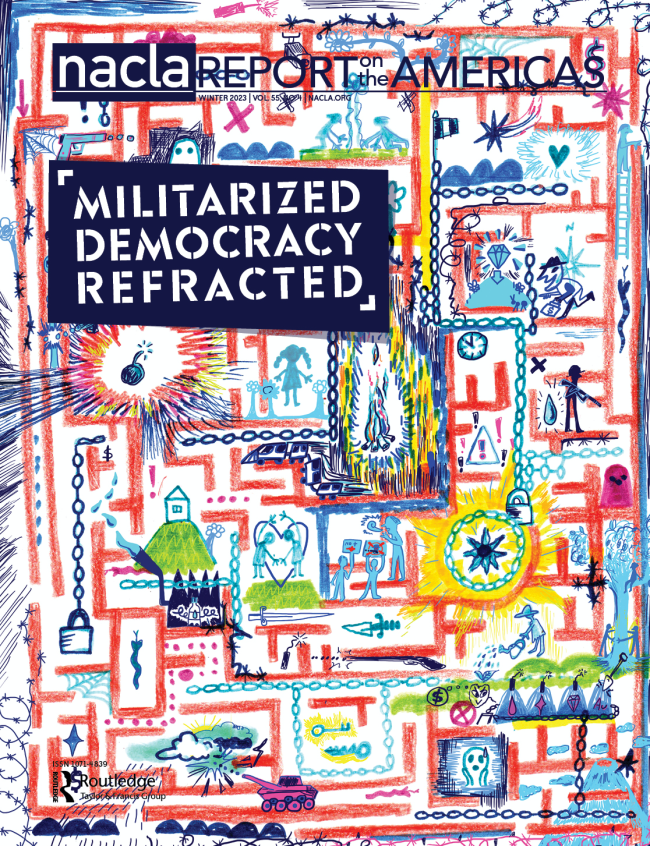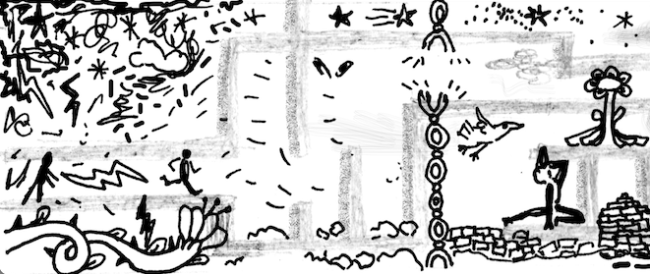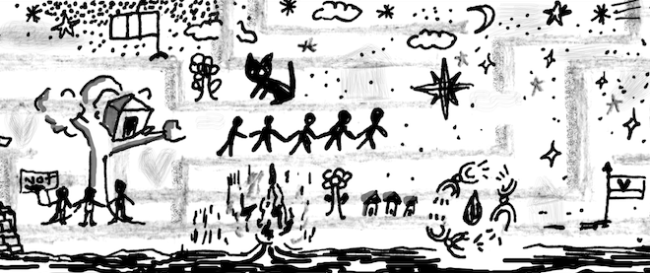
This piece appeared in the Winter 2023 issue of NACLA's quarterly print magazine, the NACLA Report. Subscribe in print today!
When thinking through Latin America and the Caribbean, especially from the United States, a great deal of attention is paid to political parties, presidents, and elections. Critical work tends to focus on the role of social movements and engage with non-state actors. But analysis positioning and understanding other institutions and systems that can constrain or accelerate political and social processes is often deemed to belong to the realm of specialists and rarely afforded space in debate and discussion.
One institution, in particular, has received too little attention. An arm of the state sometimes responsible for the very massacres and repression that fed the popular outrage that ushered in left-leaning governments on promises of making transformative change and ending violence and impunity. An institution historically linked with the worst excesses of colonialism, extractive capitalism, and unchecked abuses. An institution that, in practice, lives almost entirely off the public purse: the armed forces.
During one of NACLA’s Editorial Committee calls last fall, we realized the last time the magazine looked at militarism in a concentrated way was a quarter century ago. We knew the theme was something we needed to pursue.
Our 1998 issue, “Militarized Democracy in the Americas,” documented the expansive role of armed forces as the “guardians” of Latin America’s new democracies. Whether in the name of fighting drug trafficking, protecting borders, boosting security, or containing popular discontent, militaries remained at the ready to defend and expand the increasingly neoliberal order.
In this issue, we return to scrutinizing the role of militaries as guarantors or saboteurs of political processes, and how their power has morphed—or refracted—over time. I write from Mexico, where Andrés Manuel López Obrador has surprised even the most astute political observers with the depth and breadth of his commitment to giving the Armed Forces a central role in his sexenio.
But as I learned in the course of working on the articles in this issue, if we take a regional view, what is happening in Mexico is not so new. It’s just that the army is rarely top of mind when dissecting the pros and cons of progressive governments.

In putting together this issue, delving into the role of the armed forces in different parts of the hemisphere has been a fertile and difficult exercise. I hope the pieces collected here allow us to recalibrate how we think through politics, repression, and rebellion in the region without losing sight of the power of the armed forces.
Hugo Chávez emerged from military officialdom in the twilight of the 20th century and went on to lead one of the most exciting political transformations of our times. But the way the Venezuelan Army was woven into the fabric of “Socialism of the 21st Century” is undertheorized. The force of Chavismo, and the particular way it integrated the military into social transformation, set an important precedent as progressives went on to win elections elsewhere in the hemisphere.
For the most part, progressive cycles in Latin American countries centered on limited redistribution of wealth by the state; this was especially true during the commodity boom that lasted from 2000 to 2014. As left-wing governments came to power in the region, they persisted with and sometimes substantially increased funding and favors to the military. This can be understood as a necessary move to bring military elites on board with political projects striving toward plurinationalism and reduced inequality. More military power, especially where soldiers perform a policing function, increases the repressive capacity of the state. And from the perspective of those in power, increased military power is a double-edged sword. Those very same forces have the ability to depose leaders who lean to the left, as in Honduras in 2009, or to shift loyalties as power is contested or transferred, as in Bolivia, Brazil, and elsewhere.
Since the rebellion following the police murder of George Floyd in Minneapolis in 2020, movements in the United States have increasingly worked to strategize around and act on “non-reformist reforms” to reduce police power. If we agree that prison and police abolition is a useful frame through which to reduce state violence, critically exploring the role of the military, which carries out policing functions in countries throughout much of Latin America, becomes a natural next step.
This issue covers a lot of ground, both in space and time. In thinking through the roles and mechanisms of the so-called “first wave” of progressive governments in the early aughts, the precedent set by Venezuela is crucial. Looking back, it is plain as day that focusing on fiery speeches while avoiding a critique of the scaling up of the military—especially under left rule—was a serious oversight.
Pablo Uchoa describes the key role of the Armed Forces in public works, extractive industries, and social programs in Venezuela, from the time of Hugo Chávez through to today. Under Nicolas Maduro, Uchoa argues, the militarization of politics and society has only accelerated. And in Bolivia, Loreta Tellería Escobar examines the shapeshifting nature of Army officialdom, which enjoyed financial windfalls during Evo Morales’s nearly 14 years in office. Throughout Bolivia’s democratic period, the military has adjusted quickly to changing configurations of power, including during the political crisis that rocked the Andean country in October to December of 2019.
Then there is Costa Rica, often held up as a model following the abolition of its Army in 1949. Markus Hochmüller and Markus-Michael Müller describe efforts to brand the country as peaceful and prosperous, even as Costa Rican officials quickly remilitarized policing as an anti-communist bulwark of U.S. influence.
The pieces by Uruguayan journalist Raúl Zibechi and legal scholars Brett J. Kyle and Andrew G. Reiter take a regional view on military power. Zibechi zooms in on the confluence between regular military forces, paramilitary groups, and struggles in defense of territories firmly in the sights of transnational capital. Kyle and Reiter tease out patterns in military impunity, the militarization of public security, and the use of military courts throughout the region to evade transparency and accountability.

As a multinational force led by Kenya prepares to enter Haiti, Djems Olivier writes from Port-au-Prince about the waves of national and international security forces that have enforced unimaginable violence against the population and actively contributed to the proliferation of armed gangs. From Central America, Elizabeth G. Kennedy draws on extensive fieldwork to critique violence against women and girls by state forces in securitized El Salvador, including under President Nayib Bukele’s intensified crackdown.
Then there are the countries that have more recently broken with traditional parties and conservative rule: Colombia and Mexico. Both have long been among the staunchest U.S. allies in the region (over the past two decades, Colombia received the most U.S. military aid in the hemisphere, surpassed only briefly by Mexico at the height of the Mérida Initiative in 2012). Though the realities in Mexico and Colombia are distinct, both are still reeling from death and despojo in the wake of militarized prohibition in both past and present tense.
Gustavo Petro, a longtime leftist, was elected president of Colombia in 2022, on the back of a prolonged social uprising that shook the country. Reporting from Bogotá, Joshua Collins describes the obstacles that stand in the way of Petro’s proposal for so-called “Total Peace,” and the continuity of heavy government reliance on the scandal-ridden Colombian military.
And in Mexico, longtime democracy activist and seasoned politician López Obrador took office in 2018 after a campaign focused, in large part, on promises to rein in violence, transform the nation, and bring justice to victims, including the parents of the 43 students disappeared in Iguala, Guerrero in September 2014. As president, López Obrador has drawn the Armed Forces into managing critical logistical infrastructure formerly run by civilian agencies and the private sector.
Three articles in this issue were reported from Mexico. Nina Ebner and Gabriel Antonio Solis help us conceive of both sides of the U.S.-Mexico border at Juárez/El Paso as a strategic territory where generative synergies between militarization, manufacturing, and the control of movement are rehearsed, at great cost to migrants and the fronterizo working class.
In a feature essay, John Gibler shares new evidence showing that the Mexican military trained and armed members of the Guerreros Unidos, the paramilitary group widely believed to have disappeared the 43 Ayotzinapa students. The bombshell report, originally published in Spanish by Quinto Elemento Lab in September, breaks down the process by which the López Obrador government undermined its most high-profile investigation to protect officials from the Army and the Marines.
And I report on a shootout at a feminist event with heavy Army presence in Guaymas, Sonora, on November 25, 2021. It’s a painful irony that the women had gathered to commemorate the International Day for the Elimination of Violence Against Women. Their underreported story is an example of why the expansion of the power of Mexico’s Armed Forces is such an alarming development.
Resistance to the armed forces, their abuses, and their impunity, as well as calls for their potential abolition, might seem utopian. But history shows it can be done. The issue includes powerful poster art produced in the context of anti-militarist struggles in Puerto Rico and beyond, curated by Gilberto Arias González of the Colección GAG collective. And Diana Ramos-Gutiérrez interviews activist Myrna Pagán about the successful campaign to evict the U.S. Navy from Vieques, and the work that remains to be done.
The art in the issue was created by artists informed by feminist and anti-militarist struggles around the hemisphere. Their willingness to invert the symbolic domination of—and poke fun at—one of the most conservative, authoritarian, and patriarchal social forces in the hemisphere is a form of visual antagonism. We hope their work helps breathe an air of hope and humor into this issue.
I’m the first to admit that zeroing in on the armed forces can sometimes feel like entering an unending mire of abuse and impunity. But the better we understand existing structures of domination—especially those rarely afforded careful analysis in the media and academia—the better equipped we are to support renewed efforts to reform, transform, and even abolish them.
Dawn Marie Paley is an investigative journalist and author of Drug War Capitalism and Guerra Neoliberal. She is the editor of Ojala.mx and a member of NACLA’s Editorial Committee.
Cover artwork by Citlali Potamu aka Clara De Webo

